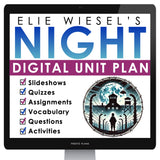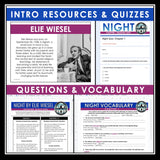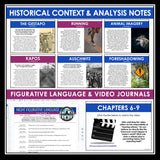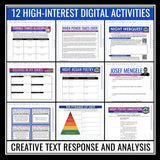Night by Elie Wiesel Unit Plan - Novel Study Memoir Reading Unit - Digital
Night by Elie Wiesel Unit Plan - Novel Study Memoir Reading Unit - Digital: This all-in-one digital unit plan provides everything you need to teach Night by Elie Wiesel in your classroom. With over 400 digital slides of content, this ready-to-use resource ensures no prep time is required! This unit includes a variety of engaging digital materials to enhance your students' understanding and appreciation of Night’s historical significance, powerful character experiences, and universal themes. You’ll find interactive presentation slides, digital assignments, historical context exploration, thought-provoking reading questions, vocabulary activities, quizzes, video journals, and hands-on interactive digital activities. This comprehensive digital Night unit plan is designed to create a rich learning experience while making lesson planning simple and stress-free for teachers.
This is a Google-compatible activity, and students complete all the work on the computer. This works well with distance learning, 1:1 classrooms, remote teaching, Google Classroom, or online education.
If you are looking for the print version of this unit, click here!
Included in the Night Unit Plan - Digital Version
➡️ Night Introductory Presentation: Introduce the memoir with this interactive Google Slides presentation. It includes pre-reading discussion questions, an interactive class activity, a biography of Elie Wiesel, historical and social context, and background information on the memoir. The presentation sets the stage for the entire unit.
➡️ Night Digital Summary Cards: These 13 digital summary cards provide an excellent classroom reference for both teachers and students. The cards highlight key plot moments from the memoir, and they can be used as a tool for struggling readers, for quick plot reference, or for finding text evidence during essay writing.
➡️ Night Self-Grading Quizzes: These short Google Forms quizzes are perfect for checking comprehension. Five quizzes, each with six multiple-choice questions and two quotes that require students to explain context, are included. Detailed answer keys are provided, and the multiple-choice questions are self-grading!
➡️ Night Digital Vocabulary Booklet and Slides: Help students learn new vocabulary from Night with this ready-to-use resource. The vocabulary digital booklet is organized by chapter sections, with students reading new words in context and inferring their meanings. They then check definitions to see if they are correct. Google Slides for easy class review are included.
➡️ Night - Video Clip Journal Prompts: Encourage students to make connections to Night with these video journals. Students watch a short video clip that relates to themes, topics, or ideas from the memoir. Each video is accompanied by a journal prompt, allowing students to reflect on the video and its connection to the text.
➡️ Night Historical Context: This 65-slide presentation provides historical context for key references in the memoir. The presentation covers topics such as Jewish life in Sighet, Nazi oppression and anti-Semitism, ghettos and deportations, survival in concentration camps, Josef Mengele’s experiments, and more. It helps students understand how Elie’s personal story connects to the larger events of WWII and is organized by reading sections based on where the references were made in the text.
➡️ Night Figurative Language Assignments: This resource will help your students examine the figurative language used in Night by Elie Wiesel. These five digital assignments include quotes from the memoir that students must label with the correct figure of speech used. The assignments are broken down into chapter sets and include detailed answer keys for easy grading or class review.
➡️ Night Questions and Answers: This resource includes reading questions organized by chapter sections. These questions cover both comprehension and analysis. Student response slides and a slide with all the questions are included. A Google Slides presentation with detailed answers, supported by text evidence, will guide students through each section.
➡️ Night Analysis Notes: This 60-slide Google Slides presentation covers the most important literary elements in Night, such as theme, recurring ideas, conflict, irony, mood, tone, symbolism, literary devices, and much more. The notes can be used for class discussions or as a guide for students to copy. These detailed notes will enhance students' understanding of the memoir.
This Night by Elie Wiesel Digital Unit Plan also includes creative assignments and activities for each reading section. You can learn more about what's included below:
Chapter 1:
➡️ “Terrible Things” Holocaust Allegory Assignment: After reading the first section of Night, students watch and listen to the picture book Terrible Things by Eve Bunting, which introduces key Holocaust themes like scapegoating and indifference. They use a digital graphic organizer to make thematic connections to Night. A sample answer key is provided.
➡️ Night Digital Thematic Tracking Assignment: Throughout the memoir, students use a digital graphic organizer to track recurring themes such as silence, identity, loss of faith, survival, and dehumanization. This tool will support their analysis and final essay writing.
Chapters 2-3:
➡️ Never Shall I Forget Digital Poetry Analysis: Students complete a guided annotation of Elie Wiesel’s “Never shall I forget…” passage, examining figurative language, repetition, and imagery to understand the emotional weight of the text. A detailed digital poetry checklist and sample annotation guide the process.
Chapter 4:
➡️ Stanford Prison Experiment Google Slides Presentation and Assignment: Using a 15-slide Google Slides presentation and a nonfiction article, students explore the Stanford Prison Experiment’s lessons about power abuse. They then complete a digital assignment, making connections between the experiment and similar abuses shown in Night.
➡️ Holocaust Shoe Symbolism Reading and Digital Design Project: Students engage with a Google Slides presentation on the symbolic meaning of shoes during the Holocaust, read the essay “Walking with Living Feet,” and answer comprehension questions. Finally, they design a shoe that reflects their own identity, linking personal expression with symbolic meaning.
Chapter 5:
➡️ Josef Mengele Nonfiction Reading Comprehension: Students read a nonfiction article about Josef Mengele’s role in the Holocaust and respond to comprehension questions to deepen their understanding of his impact and relevance in Night.
➡️ Night Poetry Connection and Digital Jigsaw Activity: Students study five poems related to the Holocaust and Night, analyze their assigned poem in small groups, then regroup to share insights in mixed “jigsaw” teams, broadening their grasp of Holocaust experiences through poetry.
Chapters 6-9:
➡️ Auschwitz Virtual Exploration Digital Web Quest: Students complete an interactive web quest featuring a virtual tour of Auschwitz, videos, and articles, gaining immersive historical context for the memoir.
➡️ Night Conflict Analysis: Through a Google Slides presentation and guided digital assignment, students identify and analyze Elie’s internal and external conflicts, exploring how these shape his beliefs and identity.
➡️ Night Irony Exploration Activity: Students examine selected Night quotes to identify verbal, situational, or dramatic irony, enhancing their understanding of Wiesel’s literary techniques.
➡️ The Perils of Indifference Digital Activity: Students listen to Elie Wiesel’s speech “The Perils of Indifference,” analyze excerpts using digital discussion task cards, connect its message to Night, and write their own persuasive speeches addressing modern injustices.
➡️ Pyramid of Hate Google Slides Presentation and Assignment: Students study the escalation of prejudice through the “Pyramid of Hate” framework, read an article on Holocaust origins, and complete a digital graphic organizer linking pyramid levels to historical and memoir examples.
➡️ Night Final Essay Topics: Students choose from ready-to-use essay prompts aligned with the thematic tracking digital graphic organizer they’ve completed, synthesizing their analysis for a final essay.
© Presto Plans
➡️ Want 10 free ELA resources sent to your inbox? Click here!








